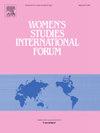The smooth skin every woman wants!: A historical look at changing trends in advertisements for U.S. women's shaving and body hair removal products (1920s–2020s)
IF 1.9
3区 社会学
Q2 WOMENS STUDIES
引用次数: 0
Abstract
In this study, I performed a qualitative longitudinal thematic analysis of 264 advertisements for women's body hair removal products (e.g., razors, depilation creams) spanning the last 100 years from the 1920s to the 2020s. Patterns of continuity and the changes in the imagery, symbolism, and written texts in these advertisements were examined. Results suggest shifting historical patterns that coalesce around: 1) the body parts focused on in the advertisements, with shifts from the underarms to the legs to pubic hair over time; 2) the messages to women about cleanliness, hygiene, and attractiveness, with a move from more overt descriptions of abjection to more subtle messages about sexuality and empowerment; 3) remarkable consistency of the virtues of whiteness, with notable lack of diversity about race, size, age, disability, and skin color; 4) changing norms of sexism, from treating women's body hair as a tainting (1920s–1950s) to seeing women as frivolous (1960s and 1970s) to overtly sexualizing women (1980s and 1990s) to selling neoliberal empowerment (2000s and beyond); and 5) limited forms of progress, particularly around expanding women's roles (e.g., athletes, working mothers). Implications for the tension between overt and more subtle forms of patriarchal control of women's bodies, the creation and maintenance of a ubiquitous body norm, and critiques of sexual objectification and neoliberal framing of power and empowerment are included.
每个女人都想要光滑的皮肤!:美国女性剃须和体毛产品广告变化趋势的历史回顾(1920 - 2020年)
在这项研究中,我对从20世纪20年代到21世纪20年代的过去100年里,264个女性体毛产品(如剃须刀、脱毛膏)的广告进行了定性的纵向主题分析。研究了这些广告中连续性的模式以及意象、象征和文字的变化。研究结果表明,围绕以下几个方面的历史模式正在发生变化:1)广告中关注的身体部位,随着时间的推移,从腋下到腿部再到阴毛;2)向女性传达的关于清洁、卫生和吸引力的信息,从更公开的卑贱描述转向更微妙的关于性和赋权的信息;3)白人的优点非常一致,种族、体型、年龄、残疾和肤色明显缺乏多样性;4)改变性别歧视的规范,从将女性体毛视为污点(20世纪20年代至50年代),到将女性视为轻佻(20世纪60年代和70年代),再到公开地将女性性化(80年代和90年代),再到兜售新自由主义赋权(21世纪初及以后);5)进步形式有限,特别是在扩大女性角色方面(例如,运动员、职业母亲)。书中还包括了男权对女性身体控制的公开形式和更微妙形式之间的紧张关系,无处不在的身体规范的创造和维护,以及对性物化和新自由主义权力和赋权框架的批评。
本文章由计算机程序翻译,如有差异,请以英文原文为准。
求助全文
约1分钟内获得全文
求助全文
来源期刊

Womens Studies International Forum
WOMENS STUDIES-
CiteScore
2.50
自引率
7.10%
发文量
63
审稿时长
79 days
期刊介绍:
Women"s Studies International Forum (formerly Women"s Studies International Quarterly, established in 1978) is a bimonthly journal to aid the distribution and exchange of feminist research in the multidisciplinary, international area of women"s studies and in feminist research in other disciplines. The policy of the journal is to establish a feminist forum for discussion and debate. The journal seeks to critique and reconceptualize existing knowledge, to examine and re-evaluate the manner in which knowledge is produced and distributed, and to assess the implications this has for women"s lives.
 求助内容:
求助内容: 应助结果提醒方式:
应助结果提醒方式:


